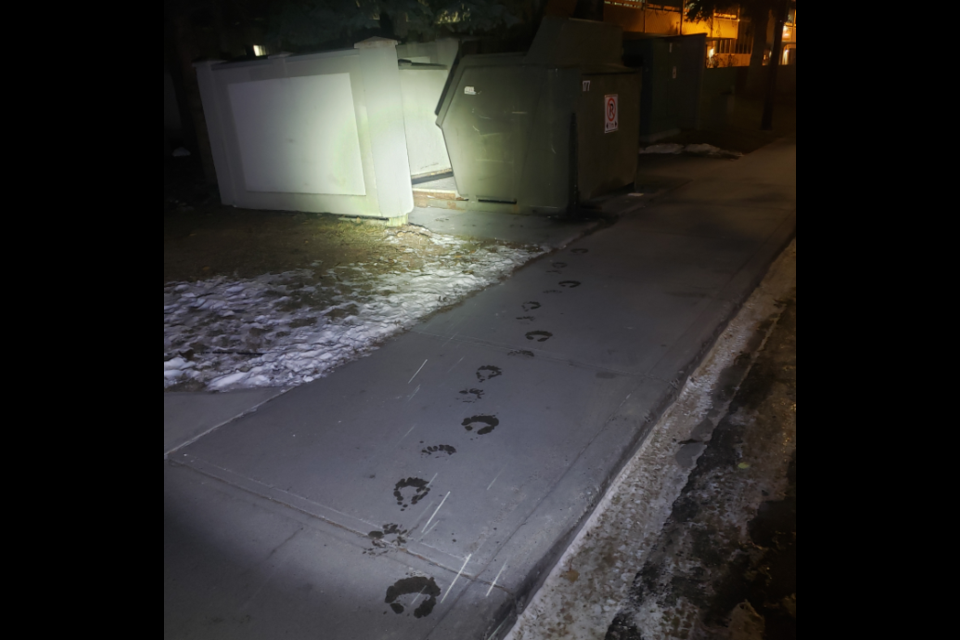BANFF – A black bear feasted on kitchen grease during an overnight raid of an unsecured storage shed at a local business.
No charges had been laid against Samesun Banff hostel as of press time, but Parks Canada law enforcement wardens are investigating the incident, which occurred during the early morning hours of Monday (Nov. 16).
Banff National Park wildlife experts say the black bear got into a 50-gallon bin filled with kitchen fat, and while nobody saw the bear, it left a trail of greasy prints when it wandered away when done eating.
“He was able to get into the shed that wasn’t secure enough, knocked over the grease bin and obviously obtained some kind of food reward based on what was in the grease bin,” said Dan Rafla, a human-wildlife coexistence specialist for Banff National Park.
“Both park wardens and Town of Banff bylaw are involved in this specific incident.”
Parks Canada first got word of this bear being in town when it was reported travelling in the forest behind a residential neighbourhood in the Marmot Crescent area about 1 p.m. on Sunday (Nov. 15).
They got the call alerting them to the incident at Samesun, which happened at the rear of the property, on Monday morning.
Rafla said nobody saw the bear during the time it was there, but the best guess is it was between midnight and 6 a.m. on Nov. 16.
“It was just the evidence of damage to the shed and and the bucket spilled over and bear prints in the area with grease on them,” he said.
Later on Monday evening under the cover of darkness, there were a series of black bear sightings around town, including on the Ken Madsen Trail.
“It was sort of all over the place,” Rafla said. “We were able to haze it a couple of times, but it was throughout the night.”
As far as Parks Canada knows, based on following its tracks, the bear left the townsite at sunrise on Tuesday. Wildlife crews don’t believe it got another food reward in town.
Rafla said Parks came up with plan to manage the bear, including setting a trap on Tuesday to capture the bear, fit it with a GPS collar and ear tag, so they can track it more closely.
“We have a bear that’s received a food reward, and considering there’s very few other natural attractants out on the landscape, it is likely going to turn to the townsite,” Rafla said.
“It hasn’t displayed any aggressive or defensive behaviour – it has fled from our staff and if people have seen it, it’s been fleeting – which all bodes well from the point of view of public risk and safety,” he added.
“But the fact that it is entering town, and frankly not just the edges, but throughout town, albeit under cover of darkness, and has had a food reward, it likely is trending towards food-conditioning and will return.”
On Tuesday, the wildlife crew spent time working with law enforcement wardens and the Town of Banff bylaw inspecting garbage bins, recycling and food composts at Banff businesses.
“We checked that they were secure and that nothing was left out, and if there were any issues, staff spoke to those business owners,” Rafla said.
“We want people to be much more diligent at securing anything that might have a smell whatsoever, so even if the bear returns, if there is nothing to reward that bear, that’s a positive.”
The bear trap has been set up in an area where Parks Canada’s tracking shows it has been travelling.
Rafla said getting a GPS collar on the animal would mean they could better manage the bear by tracking, rather than relying on reported sightings, particularly at night.
“We can start scheduling people to be on-call, or actually out patrolling at those times, so as soon as the bear enters what we call the red zone, we’d be on it,” Rafla said.
“By hazing it and constantly giving it that negative enforcement, hopefully it will change its behaviour and realize the town and human use areas are not a good place to be.”
Having a collar on the bear will also be helpful to know when the bear dens and when it comes out of hibernation in spring.
If the bear’s behaviour gets worse, the wildlife crew would consider a more aggressive aversive conditioning campaign to try to ensure it goes no further down the dangerous path of food-conditioning.
“If it thinks, ‘I got a reward in the town of Banff and I’m going to come back,’ we’ll have that GPS data,” Rafla said.
“We can then manage that bear with the ultimate goal of keeping the bear wild and living on this landscape.”
The trap is being monitored by a cellular camera, so wildlife crews get an alert if an animal has gone into the trap.
“That way we are able to respond quickly for the welfare of the animal, so it’s not stuck in that trap for very long,” Rafla said.
Parks Canada encourages residents and visitors to securely store all food, garbage, barbecues, pet food and recycling.
They also urge people to immediately report any bear sightings 24-7 to Banff dispatch at 403-762-1470.
“We really want to work hard at keeping this bear alive and wild,” Rafla said, noting someone is available to take the call around the clock.
“The sooner we know and can respond, the better off that bear will be and we’ll have a positive outcome.”
A spokesperson for Samesun did not return a call to the Outlook at press time.



